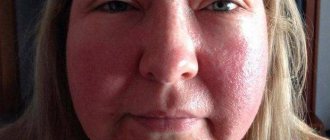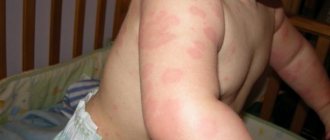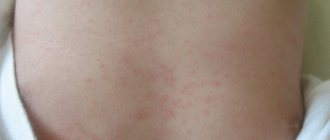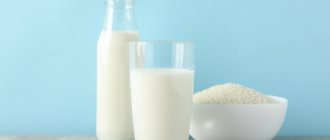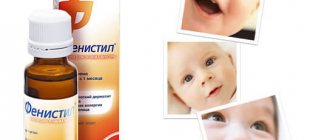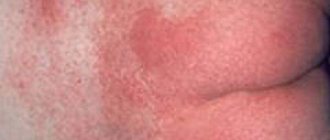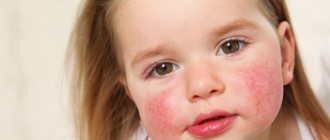Allergy to washing powder: why does it occur?
The main factor that provokes an allergy to powder is the inclusion of chemical compounds harmful to health in household chemicals. Let's find out which components in the powder potentially cause allergies?
- Phosphates. These compounds are included in most powders. They soften hard tap water, thereby increasing foaming and improving the washing properties of the powder. However, phosphates are the strongest allergens: they tend to accumulate in the fibers of matter, which leads to allergies. They also have a negative impact on the environment: phosphates enter water bodies along with insufficiently treated waste water and lead to the formation of blue-green algae.
- Zeolites. In the early 80s, many powder manufacturers abandoned phosphates, replacing them with zeolites, since at that time it was believed that zeolites were less harmful. However, over time it became clear that they are also not biodegradable and can lead to allergies, and when they get into water bodies, they lead to the death of fry.
- Surfactants (surfactants). They are included in detergents and cleaning products, as these substances help remove grease stains and other contaminants. However, most of these compounds are dangerous not only to human health, but also to the environment. The exception is non-ionic surfactants, which are completely biodegradable. The accumulation of surfactants in the body leads not only to allergies, but also to dysfunction of the liver, heart and brain. The content of surfactants in a relatively safe powder should be no more than 5% - this is enough to cope with stains, but not enough to negatively cause allergies.
- Dyes and flavors. To give powders a pleasant smell and color, manufacturers actively use fragrances, dyes and flavors of inorganic origin, which cause allergies to the powder.
- Chlorine. Despite the enhanced washing and cleaning properties of the powder, which occurs due to the chlorine content in it, this chemical element is hazardous to health. The high chlorine content in the powder leads to problems with the bronchopulmonary system, which leads to the gradual occurrence of allergies.
- Optical brighteners. These chemical compounds are luminescent dyes that give things an illusory whiteness. In fact, their particles simply settle on the fabric and reflect the light falling on them. As a result, things appear snow-white. However, you need to remember that optical brighteners are practically impossible to rinse out, which can lead to allergies.
All of these chemical compounds are difficult to rinse, which is why their microscopic particles almost always remain on the laundry. Typically, it may take up to 8-10 rinses to completely remove them from fabric fibers. The presence of residual particles on the surface of bedding and clothing causes chemicals to come into contact with the skin. This can not only lead to allergic reactions and irritation of the skin, but can also have more dangerous consequences. Harmful chemical compounds enter through the skin into capillaries located close to its surface and are carried through the bloodstream to all organs and tissues. Over time, they accumulate, which can lead to disruption of the normal functioning of body systems.
How to determine an allergy to washing powder and other household chemicals?
Allergies to household chemicals can develop gradually.
The first warning signs are catarrhal symptoms: lacrimation, sneezing, itchy nose, redness of the eyes. Many people mistake all these symptoms for manifestations of the flu or exacerbation of rhinitis, without turning to specialists and continuing to use dangerous household chemicals. At the height of the disease, more pronounced allergy symptoms occur:
- the skin at the site of contact with the allergen becomes swollen, hyperemic, may develop a rash and even crack; - itching occurs; - due to scratching of the skin, microcracks appear, which tend to fester and become severely inflamed when bacteria and fungi enter; - when inhaling detergent or perfume, signs of suffocation, swelling of the larynx, cough, and an unpleasant feeling of sore throat often appear; — against the background of the inflammatory process, regional lymph nodes enlarge; - skin itching can spread to those areas of the body that have not been in contact with the allergen.
How to determine the allergen that caused the disease?
Diagnosis of allergies is carried out by a doctor. The person himself can guess what caused the unexpected reaction, but to accurately determine the cause of the disease, certain diagnostic studies are carried out:
- skin tests; — determination of specific immunoglobulins in the blood; — biochemical analysis; — assessment of the functioning of the digestive organs and the state of the intestinal microflora.
After identifying a specific allergen, the doctor selects treatment tactics for the allergy. As a rule, the main principle of therapy is to completely limit contact with provoking factors. To date, there are no methods that 100% eliminate hypersensitivity. Allergy is a chronic disease, but you can live with it carefree by minimizing the frequency of exacerbations and avoiding low-quality cosmetics and household chemicals.
What does an allergy to powder look like and manifest itself?
- If you wash by hand, your hands and palms may become covered with small, weeping erosions.
- Allergic redness and rashes appear on the skin throughout the body.
- There is severe itching of the skin.
- Asthmatics and people with problems with the functioning of the bronchopulmonary system may experience severe coughing and difficulty breathing.
- Possible headache, dizziness, weakness.
- Sometimes there are cases of allergic rhinitis and increased lacrimation.
If you notice these symptoms, you need to contact an allergist. The doctor will conduct appropriate tests and prescribe treatment. Usually, in order to cope with allergies to washing powder, external antihistamines are prescribed. If weeping erosions and cracks occur, antiseptic and wound-healing ointments and creams are prescribed.
How does an allergy to chemicals manifest?
In direct contact with household chemicals (washing powder, bleach, stain removers, etc.), redness and a rash accompanied by itching may appear on the skin. The skin is usually dry, there may be areas of peeling and cracks.
If allergens enter the respiratory tract (aerosols, spray detergents, etc.), nasal congestion, sneezing, excessive nasal discharge, watery eyes, red eyes, and sore throat may occur. In more severe cases, there are attacks of difficulty breathing, accompanied by a painful dry cough.
Allergy to powder in a child
An allergy to powder in an infant can cause especially big trouble for parents and the baby himself.
Due to the not fully formed children's immune system and delicate skin, exposure to the powder can cause severe irritation with dryness, redness and itching. You can prevent the appearance and development of allergies to powder in newborns if you wash their clothes exclusively with organic products or special baby soap. But you shouldn’t completely trust the “non-allergenic” or “for children” labels that many manufacturers supply their powders with: it’s better to study the composition yourself to make sure there are no phosphate compounds or surfactants.
Allergy to powder in infants
In the vast majority of cases, it manifests itself as allergic contact dermatitis - inflammation of the child’s skin under the influence of allergenic components of washing powder.
In response to the antigens contained in the powder, the permeability of the vascular wall in the thickness of the newborn’s skin increases, which is manifested by redness and swelling.
Biologically active substances that appear during an allergic reaction provoke the development of itching and burning. The skin of an infant becomes more sensitive to external factors, which further aggravates the situation.
Risk factors for an allergy to powder in an infant:
- Genetic prerequisites for burden of allergic diseases. The risk of allergic contact dermatitis is higher in children whose relatives suffer from various allergic diseases.
- Artificial feeding. Natural feeding up to 4 months is a protective factor against skin allergy pathologies in children.
- Intrauterine infections.
- Living for a child in big cities.
- Antibiotic therapy.
- Autoimmune skin diseases.
Allergenic triggers of allergic contact dermatitis to washing powder in children:
- Anionic surfactants.
- Phosphates.
- Bleaches.
- Flavors.
Non-allergenic powder
Some powder manufacturers position their products as non-allergenic. However, you should not always believe advertising unconditionally. You must figure out for yourself what properties a washing powder that does not cause allergies should have, and what components should not be in its composition. In this case, you will definitely be able to buy a suitable safe product.
Avoid products whose packaging cannot read the ingredients. Many powder manufacturers deliberately indicate the list of ingredients in such small print that the buyer is simply unable to read the composition.
A high-quality powder that does not cause allergic reactions should not contain anionic surfactants. The same applies to phosphate compounds, optical brighteners and chlorine.
Buy laundry detergents that do not have a strong scent. The more fragrances and fragrances there are in the powder, the higher the likelihood of an allergy to it.
It is better to purchase washing powders not in supermarkets or markets, but in specialized stores of organic products. The products they contain have an appropriate quality certificate and do not cause allergies.
Alternative washing: what to wash things with instead of powder?
Allergies to washing powder in children and adults can be avoided by avoiding the use of most products sold in supermarkets. If you do not have the opportunity to buy organic powders that do not cause allergies, you can use the following during washing:
- Shavings of laundry soap. If you plan to wash light-colored items, you will need to add baking soda to the shavings.
- Soap root (soapwort). Safe detergent for washing wool and silk items.
- Soap nuts. Suitable for washing clothes made of any materials.
- Beans. The bean broth foams well and washes the wool.
- Mustard powder. Crushed mustard is well suited for washing woolen and silk items, as well as synthetics.
- Table salt. Effectively removes stains from chintz and linen.
What does an allergy to washing powders look like in children?
Red spots appear on the child’s skin, often with blisters filled with liquid, and there may be swelling. The baby is bothered by severe itching.
Sometimes a secondary infection occurs - yellowish crusts appear in place of the opened vesicles.
The clinical picture depends on the amount of the substance that gets on the skin of the newborn, and the initial condition of the skin itself (a brighter picture is present on previously damaged skin).
How can parents suspect an allergic reaction to household chemicals in their infant?
So, your baby is suddenly covered in red itchy spots all over his body.
First, remember: have you introduced new types of food products into your baby’s diet, have you used new cosmetics or medications?
Allergy to washing powder refers to allergic processes of delayed type hypersensitivity. Manifestations of allergies may appear 3 to 14 days after skin contact with the allergen.
If you suspect your child is allergic to washing powder, be sure to tell the doctor the name of this household chemical.
The doctor may prescribe skin patch tests for the baby to determine the exact allergen.
La-Cri products are an assistant in the fight against dry skin and allergies to powder
Depending on the nature of the symptoms of an allergy to the powder, you can use both restorative and intensive La-Cri creams. In the presence of allergic redness and itching, a restorative cream is recommended: the natural extracts and oils included in its composition provide an excellent antipruritic effect, they soften the skin and relieve redness.
If there is severe peeling and dryness of the skin, it is better to give preference to an intensive cream for very dry skin. Lecithin and allantoin, wheat germ oils, jojoba and shea butter, as well as chamomile, violet and licorice extracts effectively moisturize, nourish and tone skin areas damaged by powder allergies.
Clinical researches
The effectiveness, safety and tolerability of La-Cri products have been clinically proven. The products are recommended by the Union of Pediatricians of Russia. During clinical studies, specialists were able to record impressive results.
Cream "La-Cri" for dry skin:
- eliminates dryness and flaking;
- retains the skin's own moisture;
- protects skin from wind and cold.
Sources:
- Schneiderman Paul, Grossman Mark, Differential diagnosis in dermatology. Atlas, Binom, 2021.
- Reken Martin, Schaller Martin, Sattler Elke, Burgdorf Walter, Atlas of Dermatology, MEDpress-inform, 2021.
- Yagodka Valentina Stepanovna, Medicinal plants in dermatology and cosmetology, Naukova Dumka publishing house, 1991.
